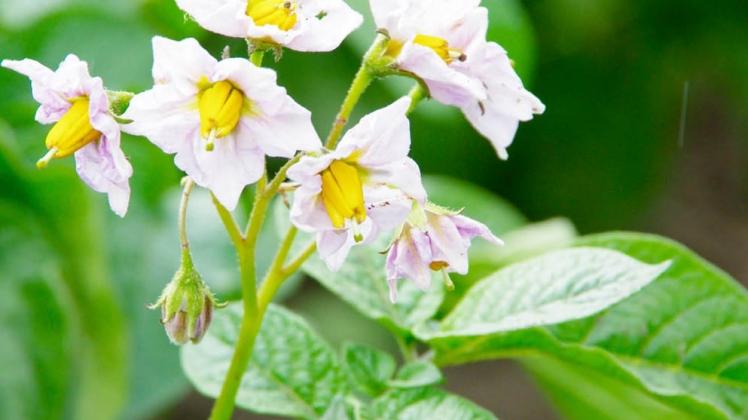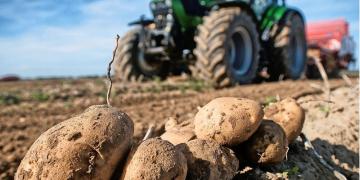Canada: Setting up fertigation in potato crops for success
Manitoba farmers show how they’ve made the irrigation-fertilization marriage work.

Potato producer Sheldon Wiebe, who farms near MacGregor, can wax poetic about how production has evolved on his operation, J.P. Wiebe Ltd., since its inception in the mid 1960s.
Like other Manitoba potato farmers, the introduction of irrigation is part of that story, but today the practice is about more than just water. Today, the farm’s pivots are also an important part of how fertilizer applications are split and applied. Irrigation eventually branched out to become fertigation, and Wiebe has noticed the benefits.
“We’ve had a lot of experience growing potatoes and, back in the day, it was very simple, very straightforward,” he said “They didn’t work with yield goals. They were just excited to have 140 bags an acre for the crop. Fertilizer was all done up front.”
Why it matters: Irrigation is already a key practice for Manitoba’s potato sector, and adding fertilizer application hits two birds with one stone.
The farm’s forays into irrigation paid immediate dividends. In 1989, the Wiebes began irrigating 60 acres with a traveling gun. Their production jumped from 140 hundredweight bags per acre to 250. As of 2007, they were irrigating 70 acres, but fertilizer was still applied up front.
A few years later, fertigation made its debut on the farm. Select irrigation passes in 2013 applied fertilizer. Again, their production jumped.
“Today we grow 2,650 acres and our yield is 500 bags an acre,” Wiebe said. “We’ve also changed our row spacing to 32 inches. That puts more plants in the field and makes a lot more ‘mouths’ to feed.”
Wiebe’s comments were made as part of a three-farmer panel on fertigation during January’s Potato Production Days in Brandon. He, along with Russell Jonk of Swansfleet Alliance and Darren White of White Potato Services, spent an hour talking about the advantages and problems of the practice.
“So, what’s the point of fertigation?” Jonk posed to the crowd. “The first reason is to reduce the leaching potential that comes along with broadcast fertilizer, but I think a better reason is that it gives me the ability to delay nitrogen applications until after we have initiation.”
Russell Jonk of Swansfleet Alliance speaks at a regenerative agriculture conference in Brandon, Man., in November 2023. photo: Don Norman
Initiation, sometimes called tuberization, begins when specialized stems called stolons emerge from the main stem and thicken. This is where the tubers form. Early in the process, as many as 30 tubers may grow, but most are later reabsorbed, leaving five to 15 potatoes to reach harvest.
Split nitrogen application is meant to increase that final productivity. Giving the plant all its nitrogen up front biases growth toward vegetative tissue like leaves and stems, rather than harvestable tubers. A smaller burst of up-front nitrogen still gives enough nutrient to get a plant started and encourages it to set tubers, while supplemental fertilizer later in the growth cycle encourages more production and yield from the plant.“We were tired of growing lush green vines and panicking in July when our beautiful set from earlier in the season somehow disappeared,” Jonk said. “So we started to look at fertigation and fertility in general.”
The potato production end of Swansfleet Alliance, located near Holland in south-central Manitoba, grows both seed potatoes and processing potatoes meant for french fries. The variety influences the fertility plan.
Jonk also has to pay attention to soil type when making fertigation plans. Holland is just west of the sandier soils of the Assiniboine Delta and the region sits on a number of different soil types and textures, ranging from finer sandy lots to heavier clay loams. Each has its own quirks to get the desired fertigation effect.
“For years we struggled with excessive vines at harvest time and we knew we were losing quality and storability by not having mature potatoes going into storage,” Jonk said. “This is when we really started looking at our fertilizer program. Our heavier soils mineralized more, especially in a warm season and we need to be able to account for that in our plants.”
Currently, the farm’s potato season starts with 100 pounds an acre of nitrogen up front. The rest is periodically applied through the season.
“Depending on the variety and the market, we set a fertigation budget,” Jonk said. “So we know roughly how much we need to put on per week to finish with fertilizing about five to six weeks before anticipated harvest date.”
He usually tries to respect the window right after seeding, after initial fertilizer is put down. It’s ideally only after tuber initiation that he starts adding nitrogen.
Very sandy or depleted soils are an exception, however, and supplemental applications might get bumped if plants are struggling. The priority is to limit vegetative growth and maximize tuber set. After that, the plant is given enough to maintain and bulk up the tubers.
Once the tuber set is established, between 25-60 per cent of subsequent nitrogen applications go through the pivot. Timing and rate are determined by inspecting the tuber set, taking soil tests, and analyzing tissue samples from selected petioles for nitrogen content.
Potatoes on display during a crop tour at the Canada-Manitoba Crop Diversification Centre near Carberry, Man. photo: Robert Arnason
Getting the rate
At J.P. Wiebe Ltd., “the first week or two of fertigation is split,” Wiebe said. “We want to make sure that if there are plants in the field that are a little bit behind, that we split applications of about 10 to 15 pounds. The other thing with this is we don’t want to wait too long in the season. We know we need to get the majority of our nitrogen on before it’s too late.”
Once Wiebe has row closure, he may apply up to 30 pounds a week in a single pass. If the soil sample comes back low, he may do a second pass.
“During the fertigation season, we’ll do three soil samples to make sure that we have enough nitrogen left,” he said. “On the last pass, we want to make sure that we have 50 to 60 pounds of nitrogen to finish the crop, nitrate plus ammonia.”
Both soil and petiole sampling (in which tissues are taken from the stalk that joins the leaf to the stem) are established ways to monitor nitrogen.
“I started out living by the petiole and then I got frustrated with them, started ignoring them and focused on soil tests,” said Darren White. “Then I got frustrated with them and realized that I needed both.”
Both measures give the farmer a partial picture of what’ happening in the field, but panelists noted observation and experience are also part of the decision-making equation.
“I can’t look at a petiole or look at a soil and say ‘fertigate this much.’” White said.
Instead, it’s a blend of how the crop looks, how much fertilizer was initially applied, how many leaching weather events have occurred “and all the things you know as a farmer out in the field touching the plants.
“Then you put the picture together and say ‘yeah, we need more.’”
It comes down to the biology of the crop on a field-by-field basis, attendees heard.
Field trialing fertigation and fertigation products is not easy, Jonk noted, pointing to the variability of irrigated fields. Good data is hard to find.
“Biological approaches on soil health are very hard to measure, but they’re also a real component to growing a healthy, storable potato,” he said. “So, my mind is going to be on collaborating and finding creative solutions to overcoming the challenges we have in making and collecting the data we need to change the way we look at feeding our crops.”
Fuente: https://www.manitobacooperator.ca/news-opinion/news/setting-up-fertigation-in-potato-crops-for-success/







